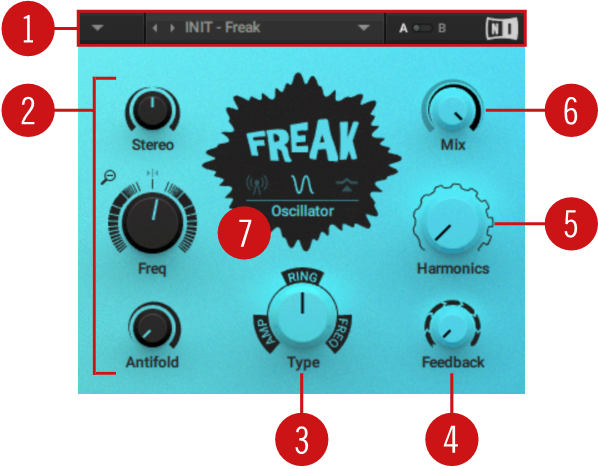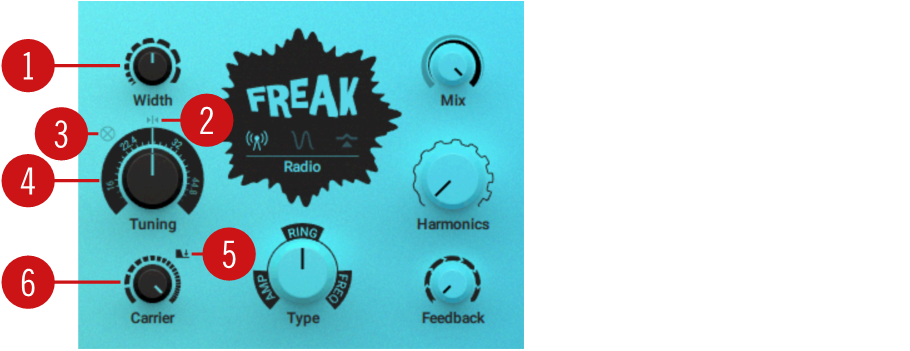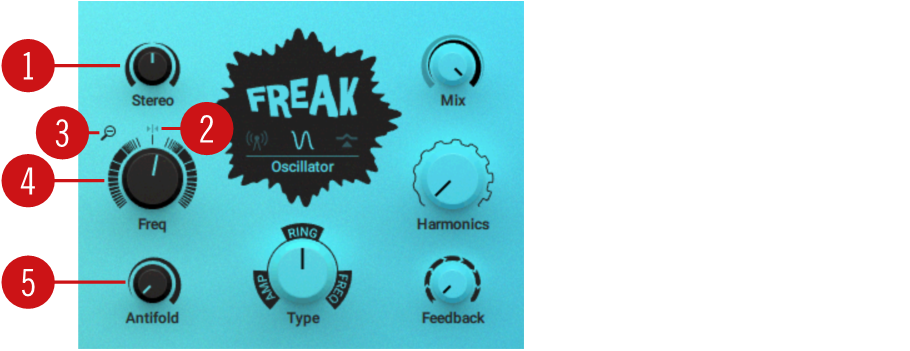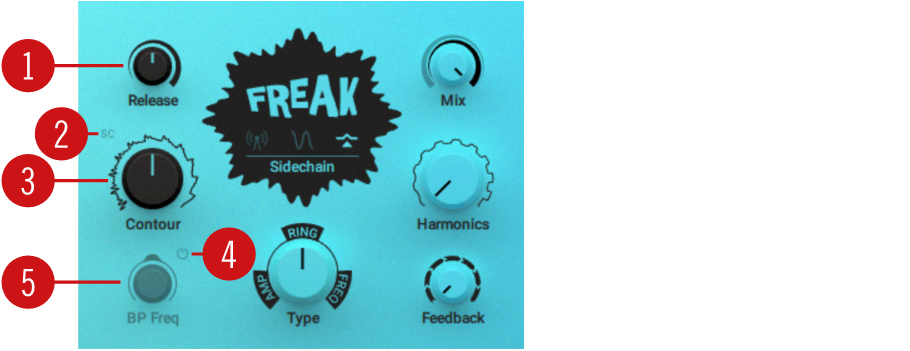FREAK
FREAK distorts sound by warping the harmonic content of signals. This section includes a note about ring modulation and frequency shifter effects and an overview of the FREAK plug-in.
In this chapter you can learn about FREAK. It includes a general note about ring modulation and frequency shifter effects and an overview of the FREAK plug-in.
About Ring Modulator and Frequency Shifter Effects
Ring modulators and frequency shifters are used to distort sound by warping the harmonic content of signals. They are based on amplitude modulation, which can create a wide range of effects depending on the specific implementation and the used modulation source.
Amplitude modulation changes the level of a carrier signal according to the contour of a modulation signal. If the modulation signal is evolving slowly, the changes in level can be heard as if turning a volume control. If the modulation signal is an audio signal, the changes in level become too rapid to be discernable. Instead, new frequencies are created, called sidebands.
Ring modulators and frequency shifters use this effect to apply harmonic transformations to a sound that add and shift frequencies, resulting in metallic and bell-like tones. FREAK combines the different techniques in a single plug-in, making it possible to smoothly morph between them. Its three modes completely change the character of the plug-in and facilitate the use of different types of modulation sources.
Overview of FREAK
FREAK combines different amplitude modulation techniques and is based on a model of an analog diode ring circuit that produces rich harmonic overtones and textures. In addition to a wide range of harmonic transformations, its three FX Modes facilitate special applications like AM radio simulation (Radio mode), tremolo and distortion (Oscillator mode), as well as gating (Sidechain mode).
In all three FX Modes the Type control smoothly morphs between basic amplitude modulation (AMP), ring modulation (RING), and frequency shifting (FREQ), while Harmonics and Feedback allow you to control the intensity of the effect. The controls on the left side are specific to each individual mode, making it possible to fully control its behavior.

Header: Provides global functions related to preset management and plug-in behavior. For more information, refer to Header and Presets.
Mode controls: These control are specific to the selected FX Mode, Radio, Oscillator, or Sidechain.
Type: Morphs between three different amplitude modulation techniques, AMP (basic amplitude modulation), RING (ring modulation), and FREQ (frequency shifting). For more information, refer to Modulation Types.
Feedback: Adjusts the level of the feedback signal from the effect’s output to its input. This increases the amount of frequencies, or sidebands, created by the amplitude modulation. When the FX Mode is set to Radio, Feedback additionally controls the amount of noise added to the signal.
Harmonics: Adjusts the amount of harmonic overtones produced by the model of an analog diode ring circuit used to implement the different amplitude modulation techniques in FREAK.
Mix: Blends between the dry signal and the wet signal by means of an equal-power crossfade.
Mode: Switches between FREAK’s three basic modes of operation:
Radio: AM radio emulation. For more information, refer to Radio Mode.
Oscillator: Pure sine wave modulation. For more information, refer to Oscillator Mode.
Sidechain: External modulation. For more information, refer to Sidechain Mode.
Modulation Types
In all three FX Modes the Type control smoothly morphs between three different amplitude modulation techniques.
Amp
The AMP mode facilitates basic amplitude modulation. At modulation rates below the audio spectrum (< 20 Hz), the level of the input signal, or carrier signal, changes slowly. This can be used for tremolo effects. At modulation rates in the audio spectrum (> 20 Hz), new frequencies are added to the carrier signal, called sidebands. The sidebands are the sum and the difference of the frequencies contained in the carrier and modulation signals. This way you can add inharmonic content to the sound while maintaining its basic character.
Ring
The RING mode facilitates ring modulation, also called balanced modulation. At modulation rates below the audio spectrum (< 20 Hz), the level of the input signal, or carrier signal, changes slowly while also periodically inverting its phase. This can be used for subtle phasing and distortion effects. At modulation rates in the audio spectrum (> 20 Hz), the carrier signal’s frequency content is replaced by new frequencies, called sidebands. The sidebands are the sum and the difference of the frequencies contained in the modulation signal and the input signal. This breaks up the harmonic structure of the sound and gives it a metallic sounding character.
Freq
The FREQ mode facilitates frequency shifting. This complex amplitude modulation technique shifts the input signal’s frequency content in the frequency spectrum by an amount that equals the modulation rate. For example, when setting a modulation rate of 100 Hz with the Freq control in Oscillator mode, all frequencies contained in the input signal will be shifted up in the frequency spectrum by 100 Hz. This breaks up the harmonic structure of the sound and gives it a metallic sounding yet distinctly tonal character.
Tip
Frequency shifting can also be used to create strong phasing effects that appear to move endlessly in the frequency spectrum (the so-called barber-pole effect). To achieve this, set Freq in a range of roughly 0 Hz to 5 Hz and increase the amount of Feedback.
Radio Mode
In Radio mode, FREAK emulates the behavior of so-called demodulation circuits in old AM radios, allowing you to create the effect “of dialing in the frequency of a specific radio station. This emulation complements the amplitude modulation techniques available via the Type control. This mode uses a sine wave signal as the modulation source.

Width: Adjusts the amount of filtering applied to the signal by changing the bandwidth of the band-pass filter used in the demodulation circuit. Low settings result in a filtered and slightly resonant sound. High settings reduce the filtering effect while adding more noise to the signal.
Center Tuning: Sets the Tuning control to center position.
Demod: Switches between emulations of two different demodulation circuits. When activated, a product demodulation circuit is used, producing an aggressive sound. When deactivated, an envelope demodulation circuit is used, recreating the sound of an old AM radio.
Tuning: Emulates the effect of tuning an old AM radio. In center position, the best possible tuning is achieved. As you move the control away from center position, the amount of radio interference increases.
Gate: Switches the noise gate on or off. When activated, noise from the demodulation circuit is only passed through if an input signal is present. When deactivated, the noise is constantly passed through, allowing you to use FREAK as a flexible noise source. The amount of noise can be adjusted with the Feedback control.
Carrier: Adjusts the frequency of the carrier used in the demodulation circuit, controlling the quality of the radio transmission. The quality improves as you increase the frequency.
Oscillator Mode
In Oscillator mode, you can explore the pure sound of the three different amplitude modulation techniques available via the Type control. This modes uses a sine wave signal as the modulation source.

Stereo: Creates a wide stereo image by adding a phase offset to the modulation applied to the left and right stereo channels.
Center Freq: Sets the Freq control to center position.
Range: Sets the range of the Freq control. When activated, Freq has a coarse range of -5000 Hz to +5000 Hz. When deactivated, Freq has a fine range of -200 Hz to +200 Hz. This gives you full control over applications that require fine adjustment of the modulation rate below the audio spectrum (< 20 Hz).
Freq: Adjusts the rate of the internal sine wave modulation used by the three different amplitude modulation techniques available via the Type control. When Type is set to AMP and RING, this allows you to change the frequency of the sidebands created in the frequency spectrum. When Type is set to FREQ, the modulation rate equals the amount by which the input signal’s frequency content is shifted in the frequency spectrum. The Freq control is bipolar, meaning that both positive (non-inverted) and negative (inverted) modulation can be applied. The range of the Freq control can be set with the Range button.
Antifold: Reduces the amount of sidebands folding over 0 Hz, producing a cleaner sound in the low-frequency spectrum. By increasing Antifold, thinner sounding distortion effects with a less tonal quality can be achieved.
Sidechain Mode
Sidechain mode opens up the amplitude modulation techniques available via the Type control for experimentation with a variety of modulation sources. It is possible to modulate the input signal with itself, or to use any external signal as the modulation source by feeding it into the plug-in’s sidechain input. Additionally, the modulation signal can be processed with an envelope follower that smoothes out the signal contour.

Release: Adjusts the attack and release times of the envelope follower. At low settings, the envelope follower quickly adapts to the contour of the modulation signal. At high settings, it responds slowly and smoothes out the contour of the modulation signal.
SC: Switches sidechain operation on or off. When activated, the external sidechain input is used. When deactivated, the input signal is used as the modulation source, allowing for self-modulation.
Contour: Blends between the direct signal from the modulation source and the signal processed by the envelope follower. This enables you to adjust how much the envelope follower affects the contour of the modulation signal.
Activate BP Freq: Switches the band-pass filter applied to the modulation signal on or off. The filter’s cutoff frequency can be adjusted with the BP Freq control.
BP Freq: Adjusts the cutoff frequency of the band-pass filter applied to the modulation signal, reducing its frequency content to a specific band. When combined with the envelope follower, BP Freq can be used to make the envelope follower respond to specific components of the modulation source.